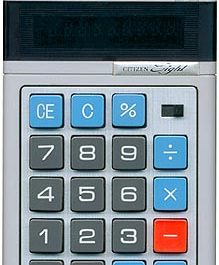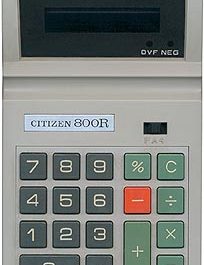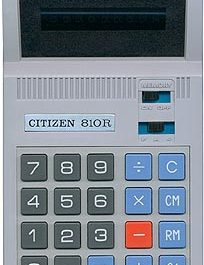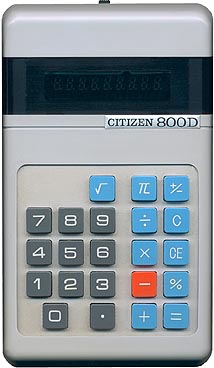
The Citizen 800D calculator, manufactured by Citizen Business Machines Inc. in Japan, represents a notable entry in the realm of handheld electronic calculators from the mid-1970s. Released in 1976, this device exemplifies the rapid technological advancements of its era, offering users a compact yet powerful computational tool.
Measuring approximately 82mm x 136mm x 25mm and weighing 134g without batteries, the 800D boasts a sleek design that balances functionality with portability. Its rounded two-piece plastic case, featuring a light grey front and dark grey back, houses a green vacuum fluorescent display (VFD) capable of showing 8 digits, with a ninth digit reserved for minus signs and error indicators.

The calculator’s interface is well designed, with an inset keyboard surround made of slightly rougher grey plastic. The soft, squishy keys provide tactile feedback through a pronounced bounce-back click, enhancing the user experience. A flat, flush, wrap-around green plastic display filter ensures a clean, easily readable output.
Powering the Citizen 800D are four AA-size batteries, providing 6.0V DC. For extended use or to conserve battery life, the calculator accepts an adaptor/charger (CTZ-800R 6V DC 0.35W) through a socket conveniently located on the top right side of the device. The power switch is centrally positioned on the top side for easy access.
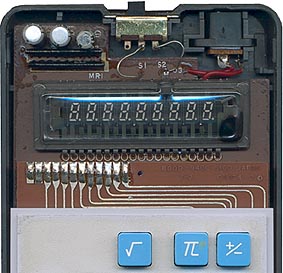
At the heart of the 800D lies the NEC µPD940C R5X71M CPU, a late 1975 model encased in a 28-pin DIL package. This processor, combined with other components such as transistors, diodes, capacitors, and resistors, forms the backbone of the calculator’s computational capabilities. The device offers standard four-function arithmetic operations, along with more advanced features like percentages, change sign functionality, square root calculations, and the mathematical constant pi.
The internal construction of the Citizen 800D is noteworthy. The keyboard assembly (model 800D 940C GK154-2 T-2, manufactured by GICO Japan) sits atop the main board, connected by a 12-way ribbon cable. This design choice likely facilitated easier assembly and potential repairs.

Logic:
- The CE key clears the last entry, while the C key clears the entire calculator.
- Input overflow is not suppressed; entering a ninth digit causes an overflow, recoverable using CE.
- Automatic constant function is available for all four arithmetic operations.
- Negative numbers are displayed with a “-” sign in the leftmost (ninth) digit.
- The change sign function can be used during number entry.
- Overflow results are shown with a “C” (or “E” if negative) in the leftmost digit and are not recoverable.
- Division by zero yields zero with an “E” in the leftmost digit, also not recoverable.
- Negative square roots are allowed and result in a negative number.
- No significant bugs were found during testing.

The Citizen 800D calculator was a well-constructed, feature-rich device for its time. While it has some limitations common to its era, such as the lack of overflow recovery and input overflow suppression, it offers a robust set of functions suitable for both basic and more complex calculations. Its clear display, comfortable keypad, and compact design likely made it a popular choice among students, professionals, and hobbyists alike in the late 1970s.
